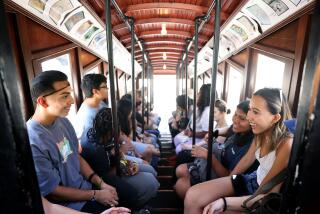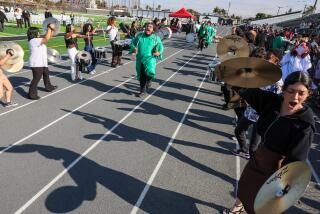Has Homecoming Lost Its Way?
Moments after being crowned homecoming king in front of 5,000 spectators, Patrick Griffiths carefully placed his crown on the ground and walked off the Mira Costa High School football field. He did so in protest against what he called a superficial popularity contest. He knew he was making a statement, but the lanky 17-year-old--a self-described âintellectual anarchistâ who doesnât believe in armed revolution--never dreamed his actions would make national headlines.
Since that night last month, Griffiths has received dozens of calls and e-mails from as far away as Canada and Australia. He also received a two-day suspension, which was later expunged from his record. Officials at the Manhattan Beach high school will not discuss the suspension, citing school district policy not to talk about individual discipline cases.
If this sounds like scenes from the 1999 black comedy âElectionâ (about a high school race for student body president that pits a âperfectâ student against a couple of unlikely opponents), it may be because it reflects the changing nature of popularity and tradition in todayâs high schools. For, while many schools still go full throttle for the fall homecoming ritual, the way they embrace the event is evolving. Some educators argue that the event simply doesnât hold the shine it once did. Others say homecoming more than ever is an important time for developing a sense of community in schools. They claim it merely needs to be updated to make it more relevant for todayâs youth.
*
For many Americans, homecoming evokes memories of an innocent era filled with pep rallies, school dances, football games and the homecoming court. For others, it calls to mind the awkward years of not belonging, of watching from outside as time after time the âinâ crowd celebrated its own.
On the night of the crowning, a friend planned to read a statement explaining Griffithsâ action but was drowned out by pregame fireworks. Griffiths later said he renounced the crown in the name of âfreaks and geeksâ and kids who were simply tired of the pressure to fit in.
âYou may not be popular, but who is popular? Thereâs about 10% thatâs popular and about 90% thatâs not . . . so maybe we shouldnât be having these kinds of contests,â he said.
Griffithsâ critics point out that the fact someone who embraces nontraditional values won shows the homecoming ritual has already changed. They say his renunciation was unnecessary and only served to mock his peers and ruin an event that took weeks to plan. Griffiths says he was trying to draw attention to the issue and spark debate.
In fact, Griffithsâ election is not an anomaly. In recent years there have been other examples nationally of nonconformists being nominated to homecoming court. Indiana University professor Robert Billingham, who studies adolescent development, believes the changing focus of homecoming reflects the society in which many students live. âIf you look at the historical setting, you did not have the diversity in the high schools. Most members in the high school class could identify with this one individual.
âWe have moved away from the idea that an individual is going to be the leader that we all look up to and emulate,â Billingham said. âThereâs more subgroup membership. The geeks and the freaks and the athletes now define themselves as equal to any other group,â he said. Thus each group is more likely to nominate one of its own.
Documentary of High School Life
R.J. Cutler, executive producer of the documentary series âAmerican High,â spent more than a year filming a group of seniors in Highland Park, Ill., a wealthy suburb of Chicago. He says heâs not surprised by Griffithsâ election--or his abdication.
Cutler recalled one of the girls he filmed, who was considered a nonconformist by her peers, frequently dyeing her hair and dressing differently. She was nominated for the homecoming court, although she didnât win. Cutler said the experience seemed of little importance to the kids, and was barely included in his series.
Leaning against a wall outside Mira Costa High School, Griffiths, who regularly wears clothing with metal studs and sports a bleach-blond and black ponytail, said he agrees the groups kids fall into may be becoming more fluid. He is also a member of the schoolâs academic decathlon team and animal-rights group, and he helps run a Web site that promotes independent photography of political events at https://www.freedomphotography.org.
Until homecoming, he was also in student government but resigned in the wake of the controversy over his action.
Some educators, however, say homecoming, with all its trappings, is now more important than ever in bringing students together, but recognize such a tradition cannot be taken for granted. For Principal Don Clasen of Annandale High School in Fairfax, Va., the timeless aspect of homecoming is what he wants for his 2,500 students who hail from 85 countries and speak 45 different languages. âIt is a way to educate kids about American tradition,â said Clasen.
Annandale retains many of its homecoming traditions from its days as a predominantly white, football-oriented school, but now its staff members take time to explain to kids the relationship between the traditions and the schoolâs community. âYou talk to a kid from Peru about homecoming court, and they donât know what you are talking about,â said Clasen.
He said 54% of his students speak English as a second language, so students who graduated from the ESL program return to the classes to talk about homecoming with newer students, encouraging them to participate in âSpirit Weekâ and to nominate their friends to the court. âIt gets them involved in the school,â Clasen explained, adding that homecoming events are some of the few in which the schoolâs entire student population is involved.
He also acknowledged that there are traditions that some newly arrived students donât buy into, such as Pajama Day. Clasen said since teachers and students increased their outreach to the ESL classes, more ESL students have been on the homecoming court each year. Although students still elect a homecoming king and queen, he said, the competition doesnât garner the same interest that it once did.
Seeking to Remold the Tradition
Administrators at Woodlands High School, near Houston, have also had to rethink the schoolâs approach to homecoming and have chosen to remold the tradition rather than scrap it. Three years ago, one of the students nominated for homecoming king was unable to attend the crowning ceremony because it fell on Yom Kippur, one of Judaismâs most sacred holidays.
âYou can bet we donât schedule homecoming on religious holidays anymore,â said Principal Don Stockton.
Last year, students and staff at Woodlands made an even bigger change, in an attempt to make the tradition more inclusive and downplay materialism. Student government president Ashley Cuellar explained that traditionally, girls at Woodlands received chrysanthemums from their dates before the proms. âGirls receive mums, boys receive garters,â she said. The problem, Cuellar said, was that kids were spending exorbitant amounts of money trying to outdo each other.
âSometimes the mums were so big the girls would wear them around their necks. They have streamers and little toys hanging off them, or even GameBoys. Itâs kind of ridiculous to spend $200 on something youâre only going to wear once,â Cuellar said. Some girls wouldnât even come to school on the day of the homecoming dance because they were embarrassed that they didnât have mums.
Last fall, student government representatives decided to encourage students to buy colorful buttons instead of the flowers, with proceeds going to the Make-A-Wish Foundation, which had bestowed a wish on one of their classmates the year before. The students organized a major publicity campaign and ended up raising $17,000. This year they raised $18,000.
âThe idea was that if you donât have a date, youâre not going to get a mum, but you [can] get a button, and itâs become a sign of cool,â Cuellar said. She added that the focus on fund-raising for the charity, as opposed to a status symbol, led to more students becoming involved in the homecoming event than in previous years. Students also increasingly have shown up at the dance with neither date nor mum.
Griffiths says he doesnât believe there is one answer to making such traditions more inclusive and relevant to students, much less to dealing with the larger issue of popularity and individuality in high school. He acknowledges that traditions are important but would like to see school unity based on something other than competitions. Most of all, he says, he is encouraged by the discussions his action provoked.
And some of his peers are benefiting, as well. Mira Costa junior Taylor Dohurty said that having felt like an outsider on more than one occasion, she is encouraged by Griffithsâ actions. Since Griffiths abdicated, she said, other students have paid more attention to her and her friends. âNow people listen to us more, not much more, but a little.â
More to Read
Sign up for Essential California
The most important California stories and recommendations in your inbox every morning.
You may occasionally receive promotional content from the Los Angeles Times.










